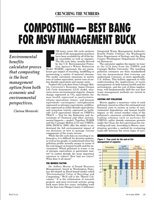
FOR many years, life cycle analyses of end-of-life management practices have been available for allof the basic recyclables as well as organics. The life cycle data, usually derived by the U.S.Environmental Protection Agency’s WAste Reduction Model (WARM), represents the net greenhouse gasimpact of recycling, landfilling or incinerating a variety of material streams. The model calculatesemissions in metric tons of carbon equivalent, metric tons of carbon dioxide equivalent and energyunits.
Product life cycle data from Carnegie Mellon University’s Economic Input-Output Life CycleAssessment (LCA) model, measures seven environmental impacts: climate change expressed as CO2equivalents; human health expressed as particulates, toluene equivalents (toxics), and benzeneequivalents (carcinogens); eutrophication expressed as nitrogen equivalents; acidification expressedas sulfur dioxide equivalents; and ecosystem toxicity expressed as herbicide 2,4-D equivalents(based on USEPA’s TRACI — Tool for the Reduction and Assessment of Chemical and other environmentalImpacts — model). Together, WARM and the Carnegie Mellon LCA tool (USEPA, 2006; EIOICA, 1995) offerthe ability to understand the full environmental impact of our decisions on how to manage variouscomponents of the waste stream.

